SUMO RULES AND BASICS

19th century ukiyo-e
of a sumo wrestler Sumo wrestling is the national sport of Japan. Once patronized by the emperors, Sumo's origins go back at least 1,500 years, making it the world's oldest organized sport. It probably evolved out of Mongolian, Chinese and Korean wrestling. In its long history sumo has gone through many changes and many of the rituals that go along the sport that seem old were in fact conceived in the 20th century. [Source: T.R. Reid, National Geographic, July 1997]
Sumo wrestlers can be found in clubs, high schools and universities, as well as in amateur associations. Both in Japan and abroad, however, sumo is best known as a professional spectator sport. Many Westerners who have spent time in Japan like sumo. The appeal of the sport lies in the intensity of the matches, the ceremony and drama that accompanies the tournaments, and all the gossip that surrounds the sumo wrestlers.
There are many religious traditions in sumo: wrestlers sip sacred water and throw purifying salt into the ring before a match; the referee dresses like a Shinto priest, a Shinto shrine hangs over the ring. When wrestlers enter the ring they clap their hands to summon the gods. In addition to wrestlers’ colorful “mawashi”(belly bands) and distinctive hair styles called “oicho”(ginkgo-leaf knot), both of which evoke images of ancient times, sumo retains many of its traditional practices, such as its “dohyo”(elevated straw ring), ranking system, and ties to Shinto religious ceremony.
Wrestlers in professional “sumo are assigned a rank according to their division; they are then designated as a member of the east or west side. The latter determines which dressing room, and therefore which side of the ring they will enter every day they compete. The highest ranks, in descending order, are “yokozuna”(grand champion), “ozeki”(champion), and “sekiwake”(junior champion). “Yokozuna”is the only permanent rank in sumo. While such men cannot be demoted due to a mediocre performance, they are expected to retire if they are not able to uphold the demanding standards of their position. Since the ranking came into existence several centuries ago, only about 70 men have ever gained promotion to yokozuna.
Prior to the actual clash in the center of the ring, the two wrestlers usually spend several minutes in a preparation ritual, extending their arms, stamping their feet, squatting, and glaring at each other. Handfuls of salt are repeatedly tossed into the air to purify the ring. After this extended warmup, a match often ends in a matter of seconds, although some may continue for several minutes, and a few even require a brief “mizuiri”(intermission) to allow the wrestlers to rest before concluding the bout. Winning techniques in “sumo”, of which there are 70, involve pushing or lifting out of the ring; using a grip on the belt to “throw” one’s opponent down; leg trips; jumping quickly to the side during the initial charge and slapping the opponent off balance; and digging in at the edge of the straw ring to toss an opponent out, just before falling out oneself.
Sumo is especially admired for its dignity and composure. Arguments over a referee’s ruling or displays of poor sportsmanship are unheard of. While vigorous open-handed slaps to the upper body are permitted, such tactics as striking with fists, kicking, and hairpulling are strictly prohibited. And although the results of some bouts are so close that the referee’s decision must be reviewed (and sometimes overturned) by the judges, neither winner nor loser ever raises a protest, and they seldom display more emotion than an occasional smile or frown.
Websites and Resources
Links in this Website: SPORTS IN JAPAN (Click Sports, Recreation, Pets ) Factsanddetails.com/Japan ; SUMO RULES AND BASICS Factsanddetails.com/Japan ; SUMO HISTORY Factsanddetails.com/Japan ; SUMO SCANDALS Factsanddetails.com/Japan ; SUMO WRESTLERS AND SUMO LIFESTYLE Factsanddetails.com/Japan ; FAMOUS SUMO WRESTLERS Factsanddetails.com/Japan ; FAMOUS AMERICAN AND FOREIGN SUMO WRESTLERS Factsanddetails.com/Japan ; MONGOLIAN SUMO WRESTLERS Factsanddetails.com/Japan
Good Websites and Sources: Nihon Sumo Kyokai (Japan Sumo Association) official site sumo.or ; Sumo Fan Magazine sumofanmag.com ; Sumo Reference sumodb.sumogames.com ; Sumo Talk sumotalk.com ; Sumo Forum sumoforum.net ; Sumo Information Archives banzuke.com ; Masamirike’s Sumo Site accesscom.com/~abe/sumo ; Sumo FAQs scgroup.com/sumo ; Sumo Page http://cyranos.ch/sumo-e.htm ; Szumo. Hu, a Hungarian English language sumo site szumo.hu ; Books : “The Big Book of Sumo” by Mina Hall; “Takamiyama: The World of Sumo” by Takamiyama (Kodansha, 1973); “Sumo” by Andy Adams and Clyde Newton (Hamlyn, 1989); “Sumo Wrestling” by Bill Gutman (Capstone, 1995).
Sumo Photos, Images and Pictures Good Photos at Japan-Photo Archive japan-photo.de ; Interesting Collection of Old and Recent Photos of Wrestlers in Competition and in Everyday Life sumoforum.net ; Sumo Ukiyo-e banzuke.com/art ; Sumo Ukiyo-e Images (Japanese-language Site) sumo-nishikie.jp ; Info Sumo, a French-Language site with Good Fairly Recent Photos info-sumo.net ; Generic Stock Photos and Images fotosearch.com/photos-images/sumo ; Fan View Pictures nicolas.delerue.org ; Images from a Promotion Event karatethejapaneseway.com ; Sumo Practice phototravels.net/japan ; Wrestlers Goofing Around gol.com/users/pbw/sumo ; Traveler Pictures from a Tokyo Tournament viator.com/tours/Tokyo/Tokyo-Sumo ;
Sumo Wrestlers : Goo Sumo Page /sumo.goo.ne.jp/eng/ozumo_meikan ;Wikipedia List of Mongolian Sumo Wrestlers Wikipedia ; Wikipedia article on Asashoryu Wikipedia ; Wikipedia List of American Sumo Wrestlers Wikipedia ; Site on British sumo sumo.org.uk ; A Site About American sumo wrestlers sumoeastandwest.com
In Japan, Tickets for Events, a Sumo Museum and Sumo Shop in Tokyo Nihon Sumo Kyokai, 1-3-28 Yokozuna, Sumida-ku, Tokyo 130, Japan (81-3-2623, fax: 81-3-2623-5300) . Sumo ticketssumo.or tickets; Sumo Museum site sumo.or.jp ; JNTO article JNTO . Ryogoku Takahashi Company (4-31-15 Ryogoku, Sumida-ku, Tokyo) is a small shop that specializes is sumo wrestling souvenirs. Located near the Kokugikan national sports arena, it sells bed-and bath accessories, cushion covers, chopstick holders, key chains, golf balls, pajamas, kitchen aprons, woodblock prints, and small plastic banks — all featuring sumo wrestling scenes or likenesses of famous wrestlers.
Japan Sumo Association (JSA)
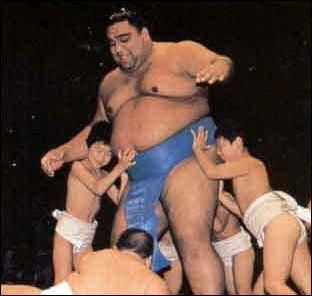
Musashimaru with kids
at exhibition event The main sumo organizing body is the Japan Sumo Association (JSA). Made up of stablemasters, the equivalent of sumo coaches and managers, it organizes the tournaments, ticket sales and broadcast rights and is a public benefit corporation that enjoys tax-free status like that of a nonprofit organization. There were 53 stables as of 2008 with JSA leaders enjoying unlimited power in the stables that they run. In recent years the JSA has let outsiders such as manga artist Mitsuru Yaku and NHK sumo journalist Hiroshi Yamamato serve on its governing committee.
The JSA is run by a 10-man board of directors made up of stablemasters, judges and top wrestlers with many members being all three. Its members have traditionally been selected through faction politics not unlike that of traditional Japanese government politics. The JSA is supposed to hold regular elections but in the past these have been ignored with board membership decided in closed door meeting with the faction leaders.
The JSA was founded in 1950. Its board of councillors is comprised of 107 stablemasters (2010), the two highest ranking referees and two representatives of JSA wrestlers. The 12-member board of directors is elected by the board of councillors. The board of councillors has the authority to call board meetings and chose the’s association’s chairman. Usually matters related to the JSA are dealt with by the board of directors.
Sumo elders are known as oyakata. They include stablemasters. The traditional thinking has been that only people in the sumo world can understand sumo and this has led to a closed culture that operates on its own terms, unobstructed by outsiders.
Only three directors — the chairman, operations chief and public relations chief’serve full time. When problems or issues arise it is usually one of these three that deals with them first. In many cases they deal with the matter and report their the solutions to the other directors, a situation that angers the lower-ranking directors. Only two of the 12 directors on the board are from outside sumo.
JSA, a Public Interest Corporation
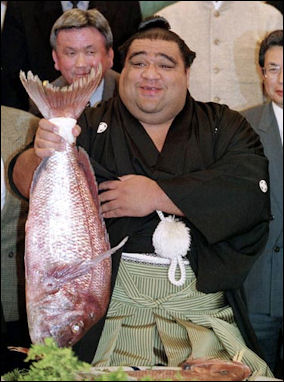
Musashimaru with victory fish The JSA is a "public-interest corporation." The term refers to an incorporated foundation or association which conducts nonprofit activities that serve the public interest. The purpose of such activities includes the promotion of social welfare, charity, academic activities, science and technology research, culture and the arts. Public-interest corporations are eligible for preferential tax treatment, such as corporate tax breaks and income deductions for donations.
According to the Yomiuri Shimbun: “In 2008, the government revised the system governing public-interest corporations, following revelations that many of them allegedly had collusive ties with ministries or agencies that had jurisdiction over them, and that their management lacked transparency. The newly introduced system, which came into force in December 2008, requires public-interest corporations to transform themselves into one of the following four forms — incorporated foundation for public interest; incorporated association for public interest; general incorporated foundation; and general incorporated association — by November 2013. If corporations do not follow this procedure, they will be automatically dissolved.”
The JSA has assets worth about $500 million, which includes land and buildings on the Ryogoku Kokugikan site, where the Tokyo tournaments are held. Most of the JSA's operating revenue comes from the six regular sumo tournaments held each year. Of the ¥10.41 billion earned in 2009 about ¥8.6 billion came from regular tournaments. With this money it pays expenses and much of the salaries of the sumo wrestlers,
Sumo Tournaments

The Japan Sumo Association, which is supervised by the Japanese Ministry of Education, sponsors six major tournaments, known as bashos ("grand sumo tournaments"): 1) the Near Year Basho (Grand Sumo Tournament) in Tokyo in January; 2) the Osaka Basho in March; 3) the Summer Basho in Tokyo in May; 4) the Nagoya Basho in July: 5) the Autumn Basho in Tokyo in September; and 6) the Kyushu Basho in Fukuoka in November. All three of the Tokyo bashos are held at Ryogoku Kokugikan. The current six-tournaments-a-year season came into existence in 1958. Before World War II there were only two tournaments year. In between the grand tournaments, the wrestlers tour the nation’s rural areas and engage in local competitions, which help to stimulate interest in the sport and attract new recruits.
The bashos are 15-day round robins, with each wrestler facing a different opponent every day. The wrestler with the best record at the end of the tournament wins. Each day, the wrestling begins around noon, with low levels wrestlers competing first in near empty arenas. The top wrestlers battle one another between 4:00pm and 6:00pm. The first “official” sumo arena, the Kokugikan, was built in Tokyo’s Ryogoku area in 1909. After World War II, the Kokugikan was moved to the nearby Kuramae area where it remained for the next four decades. In 1985, a newly built facility with seating for 11,000 opened close to the original location, near JR Ryogoku station.
Bashos last from around noon to 6:00pm. The arena is usually empty until around 3:00pm and doesn't fill up until about 4:00pm when the top-ranked wrestlers begin wrestling. During a tournament, top-ranked wrestlers in the “” makunouchi”and “juryo”divisions compete once a day for 15 days; those in the lower “makushita”, “sandanme”, “jonidan”, and “jonokuchi”divisions compete only on 7 of the 15 days. While the object is, of course, to win as many matches as possible, achieving a majority of wins in the course of a tournament (8 wins out of 15 matches, or 4 out of 7) is enough for a wrestler to at least maintain his current ranking or ensure promotion to a higher level. Victory in a tournament goes to the “makunouchi”wrestler with the most wins; ties are settled by elimination matches on the final day. Bashos are exciting because there is a lot going on and each day brings new surprises. Often the winner is not known until the last day, when the best wrestlers square off against one another.
Most tournaments have a similar plot. The yokozunas are expected to win all their bouts and the ozekis most of their, with up-and-coming mavericks trying to upset the balance and make a name for themselves. Before the tournament, the wrestlers are divided into east and west teams, which for the most parts has little meaning.
Sumo Ring

The wrestling takes place on a “dohyo”, an 18-foot-square and two-foot-high platform made of a special kind of clay. The wrestlers battle one another within a 15-foot-in-diameter ring encircled with twisted rice straw and covered with a thin layer of sand which allows the wrestlers feet to slide. The word dohyo is derived from the straw rice bag that mark the dimensions and are mostly buried in the earth.
Hanging over the dohyo, suspended from the ceiling by cables, is a Shinto shrine. Four giant tassels hang from each corner to signify the seasons of the year.
Women are not supposed to enter the dohyo as is the case with all Shinto shrines because they are regarded as "unclean" when they menstruate. Once, at the Osaka tournament, the governor of Osaka, who was a woman, wanted to present the Governor's Cup but was not allowed to and had to send a man to represent her.
Sumo Rules
The object of a sumo match is for the wrestler to force his opponent out of the “dohyo”or make him touch the surface with any part of his body other than the soles of his feet. If any part of the wrestlers's body, even the tip of a finger, touches the ground or touches outside the straw bales marking the circle he loses. If both wrestlers go flying out of the ring, the one who hits the ground first loses.
Wrestlers are allowed to slap, push, trip, and flip their opponents but kicking, striking with fists, hair pulling, eye-gouging, grabbing the vital organs, and choking are prohibited. The wrestlers can also grab their opponents by any part of their body even their neck and grab and pull on their opponents mawashi belt.
The are no size or weight limits in sumo. Because professional sumo does not adopt weight classes, it is common to see a huge wrestler compete against a much smaller man. It is not unusual for one wrestler to face an opponent that is twice his own weight. But while bulk often works to a wrestler’s advantage, speed, timing, and balance can also determine the outcome of a match, and smaller, faster wrestlers often please the spectators by pulling off upset victories over larger opponents.
Rituals Before the Day's Bouts
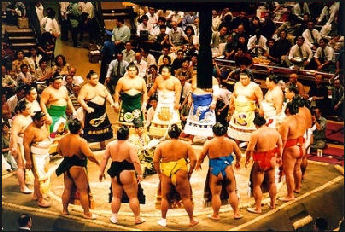
While in the locker room, before coming out to begin the tournament, each wrestler has his hair combed and oiled and tied into place so it resembles a ginkgo leaf..The slow stroking with a boxwood comb is said to help the wrestlers relax and concentrate.
“Tokoyama” are specialists who do the sumo wrestlers hair. They comb and apply “bintsuke-abura” (special hair oil) to help keep the wrestler’s top knot in place. Sometimes the process takes 30 minutes. One tokoyama told the Daily Yomiuri. “Every wrestler has different hair. Every time, I try to balance the hairdo with the face and make it different from others...relaxing wrestlers while doing to the topknot is our real job.” One wrestler said, “When the tokoyama makers makes the final touch on my topknot before the bout, I feel ready to fight.”
The main wrestling matches are preceded by a “dohyo-iri”, a ceremonial procession in which the top wrestlers walk around the dohyo in their “kesho-mawashi” (handwoven silk carpet-like aprons) to the sound of drums. The kesho-mawashi are made of silk hemmed with gold fringe and are embroidered with designs that are associated with the wrestler or his name. Each cost about $5,000 to make. They are given to the wrestlers by rich patrons.
During the dohyo-iri, the wrestlers form a circle in the dohyo, raise their hands, shouts, rub their hands together to symbolize washing before battle, and clap to attract the attention of the gods. Before they walk out of the dohyo the lift their keshyo-mawashi in a funny way (a gesture that in old days signified they weren't carrying any weapons).
Yokozuna Pre-Match Rituals

After the dohyo-iri a “yokozuna” (champion wrestler) comes out with a big rope bow tied to back of his belt and does a set ritual in which he squats, lifts his legs into the air, stamps his feet, lift his hands and glares fiercely.
The yokozuna is attended by a senior “gyoji” (referee) and two wrestlers, ones bearing a sword. The rope on the yokozuna’s belt is made of braided hemp and weighs from 25 to 35 pounds and is ornamented in the front with zigzag-shaped strips of paper like those hanging at Shinto shrines.
The yokozuna claps his hands to attract the attention of the gods, extends his arms to his sides and turns his palms upwards to show he is concealing no weapons. He then performs a heavy stomps, leaning sideways, raising each foot high into the air and then slam it hard on the ground to "stamp on the demons." with each leg to drive evil from the dohyo.
Sumo Referees and Announcers
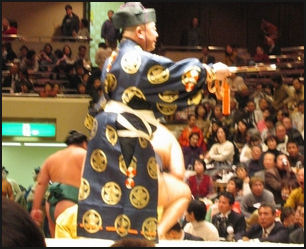
referee Dressed like a Shinto priest, the “gyoji” is both a referee and a cheerleader who announces the wrestlers name in a loud, specially-trained, high-pitched voice, shouts encouragements to the wrestlers while they are wrestling, and acknowledges the winner by waving a lacquered fan in his direction and calling out "Nokotta, nokotta" (which roughly translates to "remain there, remain there") when the match is complete.
The gyogi wear kimonos and hats of a style that was popular 600 years ago. Like wrestlers, the gyoji are ranked and only the highest level ones can work the top matches. Their rank can be determined by the color of the tassel hanging from their fan.
A man called a “yobidashi” is in charge of announcing the names of the wrestlers, while holding a fan in his hand, sweeping the sand-covered clay ring before each bout, informing the wrestlers of how much time they have left before the fight and neatly arranging the sandals of the stable master sitting beside the ring.
The “yobidashi” steps in the dohyo before each bout — holding a white fan and dressed in a yukata adorned with advertisements — to intone the names of the wrestlers in a distinctive voice, accompanied by drum beats. Yobidashi also make sure the tournaments and tours are run smoothly. They are the ones that built the dohyu and maintain it and bang the drums that bid spectators farewell. As of 2008 there were 45 yobidashi. They have ring names and are ranked and often begin their career around age 15 after finishing middle school.
Sumo Judges
Sitting at ringside in black kimonos are the officials judges, former sumo champions that ratify the referees decisions, and hold special conferences to decide close matches. There are no instant replay cameras but the judges sometimes examine foot marks and impressions in the dirt before making a decision. Occasionally, the decision of the referee is reversed or a rematch is called.
The current system of judges was introduced about a generation ago. In one of the first matches in which the panel of judges overruled a referee, the referee was so depressed over losing face he committed suicide. I watched a match on television in 1998 in which a wrestler fell on a judge and broke his arm but the judge didn't seek any medical attention until after that day's matches were over.
Rituals Before a Sumo Bout
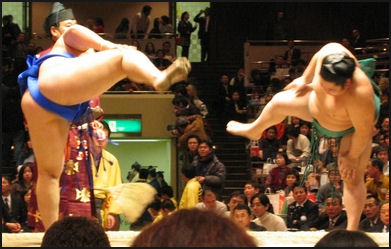
Before they enter the dohyo, the wrestlers wash out their mouths with water sipped from a wooden ladle, and ritually rinse their mouth with sacred water. This is similar to what visitor do before praying at a Shinto shrine, where they are required to wash their hands and mouth in a natural spring or rock-hewn pool before entering a shrine to purify themselves.
Before a bout, sumo wrestlers perform ritual “shiko” exercises like those performed by the yokozuna in his pre-tournament day ritual. They rub themselves with a paper towel to cleans the mind and toss salt in the dohyo to purify the ring. The salt-throwing is also supposed to protect the wrestler from injuries. Moments before the match commences the wrestler exchange a respectful bow and crouch in the "get set" position and touches their fist to ground. The wrestlers often fiercely stare down each other a couple of times, retreat to their corners and return to their starting places before they start wrestling. This ritual is called “shikiri” and usually the wrestlers do it for the full four minutes allowed by the rules. It helps the wrestlers psych themselves up and builds up the anticipation by the crowd. In the old days these lasted for a long time. In 1928, a ten minute limit was imposed, and over the years it has been reduced from seven, to five and then to four minutes.
Before some “makunouchi”division matches, attendants can be seen circling the ring holding pennants displaying the names of corporate patrons that donate cash prizes to their favorite wrestlers. The more pennants there are, the larger the prize, this being handed to the winner by the referee upon completion of the match. Squatting at the edge of the ring, the winner accepts his prize while making a gesture, called “tegatana”(hand sword), that signifies his grateful acceptance.
Sumo Match
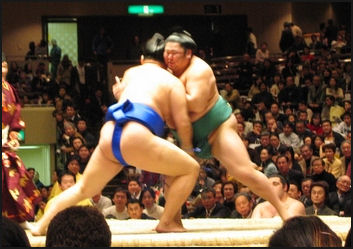
The match begins with a “taich-ai” (initial charge). Before the taich-ai both wrestlers are in a crouching position with their hands in a fist. They stare down each other. Once both are ready, they touch the knuckles of both hands to the dohyo and charge. Often it looks the wrestlers only touch one hand because they first touch the ring squarely with one fist, and the lightly touch the second hand as they launch into the taich-ai.
Sometimes one wrestlers jumps the gun. The referee then calls for new start and the transgressor bows and apologizes to his opponent. Then they try starting again. Often the wrestlers don’t touch both hands to dirt. In 2008, the Japan Sumo Association insisting that both wrestlers touch the dirt with both hnads and called for judges to rigorously enforce the rule. YouTube video however showed that several wrestlers still did not bring both fist to the dirt before launching into their taich-ai and also dug up old video showing that the judges often did the same thing when they were wrestlers. .
The average length of a sumo match is a few seconds, Rarely does a match last more than a minute. Sumo last one or two seconds. Describing one match between the famous wrestlers Akebono and Takanohana, T.R. Reid wrote in National Geographic: "With their fierce muscles wrapped around each other's bounteous bellies, the two carried on an elephantine pas de deux that lasted more than a minute — a long match by sumo standards. Finally Akebono got his opponent backed against the edge of the ring and Takanohana went crashing backward out of the ring, with Akebono's bulk smashing down on top of him."
Sumo Technique
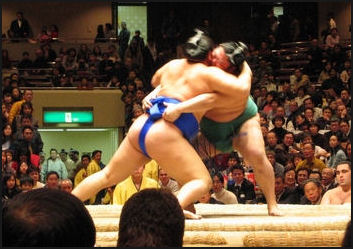
grabbing the belt The best sumo wrestler are huge, fat and agile. Smaller, lighter wrestlers can sometimes outmaneuver their larger opponents but more often than not the biggest wrestler wins. It is good to have relatively short legs and a low center of gravity. According to former yokozuna Musashimaru upper strength is important but the low half is what counts. Wrestlers that lack the latter look unbalanced.
There are over 70 different moves that can be used to bring an opponent to the ground or thrown him out of the ring. There are 48 recognized sumo techniques. They all have names like "beltless arm throw" or "one leg trip."
Powerful wrestlers often begin the match with a ferocious slapping and shoving attacks that send their opponents reeling out of the ring. The throat grip is another effective maneuver. A common tactic for small wrestlers against a larger opponents is to side-step his rival's charge and then push him out of the ring with a powerful shove to the back.
Some wrestlers are pushers and thrusters who attempt to push their opponents out with their taich-ai, initial surge and slapping and pushing attacks. Others are mawashi men who like to get a good grip on their opponent’s belt and throw home down or maneuver him out of the ring.
Sumo Wrestler's Belt
The wrestlers compete barefoot and wear a “mawashi”, the distinctive wrestler’s loincloth-like belt which is 2-feet-wide and 10-meters long. It is folded sideways six times and then wrapped around the waist from four to seven times, depend on the girth of the wrestler, and attached around the groin with a strap. Sometimes wrestlers wet their mawashi, which makes it tight so its is hard to grip. Sometimes wrestlers loosen the their mawashi, which makes it loose so its is hard to grip.
The mawashi in many ways makes sumo the unique sport that it is, The primary objective of many wrestlers is to get the grip on the belt they want and then use that grip to throw their opponents. The majority of 70 sumo techniques involve the mawashi. The chords dangling from the front of the belt are made of silk stiffened with glue and are purely ornamental. They frequently become detached during a match.
During a match it often looks like the mawashi is going to come apart or fall off but that almost never happened. In 2000, however a low-level wrestler named Asanokiri endured the embarrassment of having his mawashi fall off in the middle of a bout, exposing his private parts. It was the first time in 83 years such a thing had happened.
The belt loss was televised but few people saw it because it occurred in a match that was of such a low level few were watching. Afterwards Asanokiri said, "I tied my mawashi the way I always do, but today it just came lose." In the old days it wouldn't have made much different because women weren't even allowed to watch the matches. It wasn't until Japanese began worrying about what European Christians thought of them that they penalized wrestlers whose belt came off.
End of Sumo Match and Bow Twirling
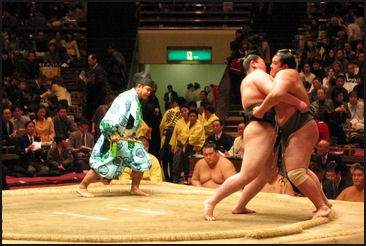
The dohyo sits on platform about above the audience. Sometimes wrestlers take spectacular tumbles off the platform into the audience. And, it’s a miracle that people don't get seriously hurt from time to time.
The decision of the referee and judges is final and the wrestlers and the fans never complain. The wrestlers are expected to take their victories and defeats with equal dispassionate stoicism but sometimes you can see a hint of a smile or a look of disgust or disappointment on their faces. When a match ends, the wrestlers bow respectfully to each other. The loser departs immediately while the winner hangs around for a while, drinks some water and squats while being recognized as the winner by the referee.
Each day of the tournament concludes with the "bow match," in which a specially-picked wrestlers climbs into the dohyo and is handed a bow by the gyoji. The wrestlers twirls the bow around like a baton. The rituals dates back to Edo period when the winning wrestlers were awarded the prize of a box and they showed their satisfaction by doing the "bow dance."
According to the Japan Sumo Association Web site, the bow-twirling ritual at the end of the day’s bouts stems from an Edo Era tradition in which the winner of the final bout on the final day of a tournament was awarded a long bow. The victor would perform a dance, including twirling the bow, to express his satisfaction.
The bow twirling to make the end of the day’s matches has traditionally been performed by low-ranked wrestlers. In principle, the bow-twirler I supposed to comes from the stable of a yokozuna but that doesn’t always happen because sometimes no suitable candidate can be found in that stable. One such wrestler who performed the ritual in 2010 — Chiyonohana, the No. 34 sandanme — said he was proud of his role as bow-twirler. "It's not something just anyone can do," he told the Yomiuri Shimbun. "I'm thankful [to get the chance]." [Source:Tomohiro Okada, Yomiuri Shimbun, January 29. 2011]
Sumo Tournament Winners
The winner of the basho is the yusho (championship title). He is given the Emperor's Cup, which he gives back at the next tournament. In addition, special prizes are given for Outstanding Performance (the wrestler who upset the most yokozunas and ozekis), Fighting Spirit, and Technique.
At the end of the tournament, the winner is honored in an elaborate ceremony with a band playing the Japanese national anthem and Handel's “Hail, the Conquering Hero”. In addition to the hefty Emperor’s Cup, he is given two tons of rice, a ton of chestnuts, grapes and pears, four tons of onions, a year's supply of sake, a bunch of cups and other prizes. and sometimes a new car or all terrain vehicle. Presenting all the prizes sometimes takes almost half an hour.
The winner usually accepts the awards stoically, thanks his mother and fans, and walks out without saying anything to reporters. In the after-tournament party at their stable (club), the winner dons a kimono, drink sake from a huge bowl and holds up one or two large fish (usually a reddish colored sea bream) for photographers.
Wrestlers below the rank of ozeki that achieve winning records during the tournament become eligible for three special awards: the Outstanding Performance, Technique, and Fighting Spirit prizes. These are accompanied by cash bonuses. Another incentive to wrestlers is the “kimboshi”(gold star), awarded to a lowerranked wrestler who manages to upset a “yokozuna”. Each additional “kimboshi”entitles the wrestler to an incremental boost in his salary for the remainder of his active career.
Sometimes thick packets of money, called “kensho”, are given to winners of bouts featuring popular wrestlers. Each envelope contains ¥55,000 of which ¥25,000 goes to tax man and ¥30,000 goes to wrestler. Basho champions often walk away with 300 or so kensho in addition to the ¥10 million they get for winning.
Sumo Fans
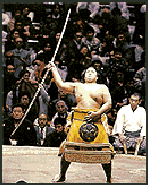
the sign a day's
bouts are
finished Up until a few years ago, almost all sumo tournaments had sellout crowds, and people waited in long lines for the tickets which inevitably sold out the first day they went on sale. But these days interest in the sport has declined somewhat and sometimes there are empty seats in sumo arenas. In any case, all the matches are broadcast live on television.
The main sumo arena in Tokyo holds 11,000 people and is specially designed for viewing the sport. The spectators near the ring sit on cushions on the floor or little platforms and eat sushi and bento lunches and drink sake while watching the action. The 300 seats nearest the ring are allocated to individual, corporate and group sponsors who donate ¥1.3 million or more to the JSA.
Fans throw their cushions in the air if there is a major upset. They are supposed to do this only when a yokozuna loses. The Japan Sumo Association frowns on the practice, worried about injuries, and wants it to end. In 2009 new redesigned the cushions were put in in the stands. They are 1.25 meters wide and fit under two people instead of one and can be tied together so it is difficult to toss them. .
Fans often wait in the streets to welcome the wrestlers when the arrive at the tournaments dressed in yukata and sandals. The top wrestlers often arrive in chauffeur-driven vehicles while lower ranked rikshi arrive in a taxi or even walk from the nearest subway station.
Image Sources: Nicholas Delerue except the ukiyo-e (Library of Congress) and pre-bouts ritual and end of day (Japan Zone)
Text Sources: New York Times, Washington Post, Los Angeles Times, Daily Yomiuri, Times of London, Japan National Tourist Organization (JNTO), National Geographic, The New Yorker, Time, Newsweek, Reuters, AP, Lonely Planet Guides, Compton’s Encyclopedia and various books and other publications.
Last updated January 2013
